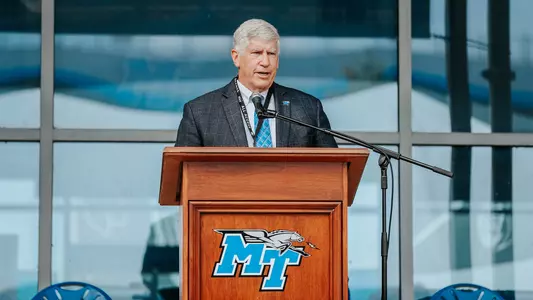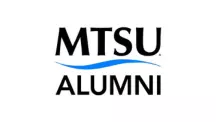Middle Tennessee State University Athletics

"We can learn that leaner is better": Catching up with Director of Athletics Chris Massaro, Part 1
6/12/2022 12:30:00 PM | General
MURFREESBORO, Tenn. — It has been a year of so many changes across the college athletics landscape, from continuing to get the COVID pandemic under control, to NIL deals and the Transfer Portal giving student-athletes more options than ever, to the dominos that fell from conference realignment over the fall.
Amidst all the change, Middle Tennessee Athletics continued its long tradition of excellence, with successful seasons across the athletic department during this spring semester, led by a Conference USA Championship from men's tennis and an individual C-USA Title for men's golfer Michael Barnard, an East Division title for Men's basketball, along with a WNIT Semifinal run for women's basketball. And, most recently, five track and field athletes qualifying for the NCAA championships.
But those changes, both large and small, present great challenges and, as director of athletics Chris Massaro said, great opportunities to continue to thrive in the new status quo.
Staff Writer Sam Doughton caught up with Massaro shortly after the C-USA Spring meetings to recap the semester, take a look at how Middle Tennessee is adapting to those changes, and look ahead to the future of Conference USA.
Part Two of this Q&A, featuring updates on projects in the Build Blue Now campaign as well as a look at how your support of the Annual Fund helps support MT Athletic's mission, will be released on Monday evening.
The following conversation has been lightly edited for length and clarity.
Another successful semester on and off the field at Middle Tennessee, particularly during the winter season with basketball and track and in the spring with men's tennis. How much did you enjoy watching our teams throughout the past few months?
I think the winter was great. We saw a dramatic improvement in men's basketball, which we were all hoping for and expecting, and it came together. That future appears bright. You don't want to take women's basketball for granted, Coach Insell has made the postseason every season he's coached. He's never gone to a conference tournament without a bye, which to me is an incredible record. The run that they made in the WNIT was a lot of fun for everybody. And the fact that the nucleus of both the men's and women's teams are returning creates a lot of excitement around those two programs.
In the spring, you think about our old standard bearers. Track and Field, which has five student-athletes competing in the national championship. That's an awesome accomplishment. And you can't talk about spring without talking about the performance of our men's tennis team and what they accomplished. The job that Jimmy Borendame has done, both on the court and off the court, the climb and the breakthrough that he had, to be a top 16 seed, that's where we want the program to be. It's provided the blueprint for continued improvement in that program. Baseball had its best RPI in at least ten years. We didn't like the way it finished in the conference tournament, so there's still some work to be done.
There's work to be done in some of the other spring sports, and I am confident we will improve in those sports.
We had a very good academic semester, that's always the most important thing we do. We graduated over 40 student-athletes in spring commencement. Our cumulative GPA is over a 3.0, so our student-athletes are doing a great job in the classroom.
Looking a bit more broadly at the college athletics landscape, so much has changed in just one year from where we were in August, from NIL, to COVID, to the new normal of the Transfer Portal. How have you seen some of these changes affect the athletic department?
It's been an unbelievable year when you wind back the clock. We tend to forget where we were a year ago with regard to COVID and its uncertainties. The good news is that we survived most of the year without much COVID disruption. We had some COVID disruption in football, where we had eight or nine guys that were not able to play at Charlotte, and we lost a close game there. We had some interruptions with men's basketball. But from where we were last spring, to be able to really complete all of this school year with very few restrictions on fan attendance, that's remarkable progress, and I'm really proud of the administrative team for being able to get on that.
This time last year was when it started breaking that Texas and Oklahoma were joining the SEC. We knew that would have a seismic impact on things. I don't think anyone could've predicted the way it all fell. We knew there would be massive change. The real surprise was when the American Athletic Conference took six schools from Conference USA. I think the number of schools surprised me most. That action squared us right in the conference affiliation game.
I'm just glad it worked out the way it did. There's a real will among the remaining Conference USA presidents to get better. The four new members coming in are really eager and ready to go. I think we've got a chance to make this a leaner, tighter conference and make it better than what we've been in. That must be our goal.
So that massive change in November was incredible. And then you throw in the transfer portal and NIL and how that's changed across the country. We're still seeing the impact of that. Nationally, we're seeing a ton of kids that are still in the transfer portal that will not get signed, that are just kind of dead in the water. I'm hoping that there will be a leveling out.
Hopefully, some of the crazy stories you're hearing about the NIL deals will slow down, because to me there's a difference between pay-for-play and NIL. Student-athletes deserve to make money on their name, image and likeness, but if it just becomes outbound pay-for-play, that's a different set of rules, in my opinion. The long term solution is that there will be some sort of national or regional uniformity on this soon. Whether the conferences do it themselves, the NCAA does it, Congress does it, the courts do it, or a combination of all the above. But that will take some time to sort out.
What we need to do is that any time there is great change that means there's great opportunity. We need to position ourselves to be at the cusp of this change and to come out of it better. I think with our Build Blue project, that's going to be a tremendous help in the modern world of collegiate athletics. We need to be aggressive in the NIL game.
We're prepared. And as the world changes around us, we need to make sure that we can pivot quickly. But we also need to make sure that we remain true to our educational roots. If we do that, we're going to be successful.
To dig a little deeper, it appears a lot of the coaches at MT have adapted to the modern reality of the transfer portal. What have you seen them do well to adapt to that big change?
It's either adapt or perish. We're going to lose players in the portal in some of our sports, and we'll lose some that would've helped us in the future. But we can't focus on what we've lost, we've got to focus on what we can gain. At the end of the day, we need to be on the plus side of that.
What I preach to the coaches is that team culture now is really a nine-month, six-month deal. What I mean by that is our rosters are turning over quicker than ever. So, you can't rely on that three or four-year culture. Culture has to be implemented and enforced every day. The newcomers that come in, and they're coming in bigger numbers than they ever have, must become a part of our culture.
I don't like phrases like 'we need to recruit our kids every day.' I think it's more like: 'let's provide a culture where they can thrive.' And thriving doesn't mean that every day is a beautiful day. Sometimes, you have to tell a person a hard truth for growth. But if your culture is strong, and your culture allows that, you're going to be fine.
That's the balance we have to walk, and it has to start at ground zero in your locker room. People want to be a part of that culture. You can attract people that are seeking the holistic student-athlete experience, seeking an organization that cares about them as an individual.
With the 11 schools competing in Conference USA next season, that has necessitated some changes to the season structure, such as the removal of divisions in football and a 20-game conference schedule for basketball. What has been your reaction to those changes?
I think it's going to be just fine. The common fan probably won't see much of a difference. There are some really good schools that we're competing against, and it's our last go-around with this group of schools. I'd really like us to make a statement. This is the last year this iteration of the league will exist until we all transition into a different kind of league. So, let's make that lasting impression, let's throw that gauntlet down and let's win as many championships as we can.
With the 20-game conference schedule in basketball, I really like that because we'll play a double round robin, meaning we play everyone in the league home and away. We'll be able to crown a true regular season champion. Your No. 1 seed in the conference tournament will have truly earned it.
The four incoming members to Conference USA — Liberty, New Mexico State, Jacksonville State and Sam Houston State — were at the conference meetings just before Memorial Day Weekend. How exciting was it to be a part of that group of nine schools looking towards the future of Conference USA?
We're still in that 'let's get to know each other process,' a little bit. But at the new Conference USA level, we're also focused on 'how do we get better?' Let's take football for example. We can talk about the TV contract, which is one tool to improve our programs. But the real goal is to improve our CFP ratings. That's where there are some revenue opportunities. How do we as a league get better? And it all starts with each individual school getting better.
You look at the football coaches, particularly with some of the new members. Rich Rodriguez at Jacksonville State, for example, that guy has had a lot of success. New Mexico State with Jerry Kill, that guy has had a lot of success. Liberty with Hugh Freeze, that guy has had a lot of success. Sam Houston State, their coach K.C. Keeler, he's got a national title ring with the Bearkats.
Then you look at FIU, who did not have a very good year last year, and Mike McIntyre is now there. And Mac has had a lot of success in the Mountain West and Pac-12. You look around the football room, with the ideas that are being generated by guys that have coached in the Pac-12, the Big Ten, the SEC. It was a really great dialogue that gave me a lot of added hope for the future, because that's the key to conference branding, how well you do in football. And the most important part of that are your head coaches.
From there, you look at men's basketball, you start examining those programs. The success New Mexico State, Liberty, Western Kentucky, Louisiana Tech and we here at MT have had over the years, there's a lot of great men's basketball history. And you can't write the history of college basketball without UTEP, either. This is going to be a great men's basketball league.
We can learn that leaner is better. Let's go with a small membership number to start with and see where that can take us. I think if people give this new league a good look, they're going to see really good things. And now we must go out there and prove it. That's where the collective will of all of these presidents is going to come into play. I'm really encouraged by us staying in Conference USA, because those five remaining presidents have a point to prove. So, let's go out there and get it done.
Amidst all the change, Middle Tennessee Athletics continued its long tradition of excellence, with successful seasons across the athletic department during this spring semester, led by a Conference USA Championship from men's tennis and an individual C-USA Title for men's golfer Michael Barnard, an East Division title for Men's basketball, along with a WNIT Semifinal run for women's basketball. And, most recently, five track and field athletes qualifying for the NCAA championships.
But those changes, both large and small, present great challenges and, as director of athletics Chris Massaro said, great opportunities to continue to thrive in the new status quo.
Staff Writer Sam Doughton caught up with Massaro shortly after the C-USA Spring meetings to recap the semester, take a look at how Middle Tennessee is adapting to those changes, and look ahead to the future of Conference USA.
Part Two of this Q&A, featuring updates on projects in the Build Blue Now campaign as well as a look at how your support of the Annual Fund helps support MT Athletic's mission, will be released on Monday evening.
The following conversation has been lightly edited for length and clarity.
Another successful semester on and off the field at Middle Tennessee, particularly during the winter season with basketball and track and in the spring with men's tennis. How much did you enjoy watching our teams throughout the past few months?
I think the winter was great. We saw a dramatic improvement in men's basketball, which we were all hoping for and expecting, and it came together. That future appears bright. You don't want to take women's basketball for granted, Coach Insell has made the postseason every season he's coached. He's never gone to a conference tournament without a bye, which to me is an incredible record. The run that they made in the WNIT was a lot of fun for everybody. And the fact that the nucleus of both the men's and women's teams are returning creates a lot of excitement around those two programs.
In the spring, you think about our old standard bearers. Track and Field, which has five student-athletes competing in the national championship. That's an awesome accomplishment. And you can't talk about spring without talking about the performance of our men's tennis team and what they accomplished. The job that Jimmy Borendame has done, both on the court and off the court, the climb and the breakthrough that he had, to be a top 16 seed, that's where we want the program to be. It's provided the blueprint for continued improvement in that program. Baseball had its best RPI in at least ten years. We didn't like the way it finished in the conference tournament, so there's still some work to be done.
There's work to be done in some of the other spring sports, and I am confident we will improve in those sports.
We had a very good academic semester, that's always the most important thing we do. We graduated over 40 student-athletes in spring commencement. Our cumulative GPA is over a 3.0, so our student-athletes are doing a great job in the classroom.
Looking a bit more broadly at the college athletics landscape, so much has changed in just one year from where we were in August, from NIL, to COVID, to the new normal of the Transfer Portal. How have you seen some of these changes affect the athletic department?
It's been an unbelievable year when you wind back the clock. We tend to forget where we were a year ago with regard to COVID and its uncertainties. The good news is that we survived most of the year without much COVID disruption. We had some COVID disruption in football, where we had eight or nine guys that were not able to play at Charlotte, and we lost a close game there. We had some interruptions with men's basketball. But from where we were last spring, to be able to really complete all of this school year with very few restrictions on fan attendance, that's remarkable progress, and I'm really proud of the administrative team for being able to get on that.
This time last year was when it started breaking that Texas and Oklahoma were joining the SEC. We knew that would have a seismic impact on things. I don't think anyone could've predicted the way it all fell. We knew there would be massive change. The real surprise was when the American Athletic Conference took six schools from Conference USA. I think the number of schools surprised me most. That action squared us right in the conference affiliation game.
I'm just glad it worked out the way it did. There's a real will among the remaining Conference USA presidents to get better. The four new members coming in are really eager and ready to go. I think we've got a chance to make this a leaner, tighter conference and make it better than what we've been in. That must be our goal.
So that massive change in November was incredible. And then you throw in the transfer portal and NIL and how that's changed across the country. We're still seeing the impact of that. Nationally, we're seeing a ton of kids that are still in the transfer portal that will not get signed, that are just kind of dead in the water. I'm hoping that there will be a leveling out.
Hopefully, some of the crazy stories you're hearing about the NIL deals will slow down, because to me there's a difference between pay-for-play and NIL. Student-athletes deserve to make money on their name, image and likeness, but if it just becomes outbound pay-for-play, that's a different set of rules, in my opinion. The long term solution is that there will be some sort of national or regional uniformity on this soon. Whether the conferences do it themselves, the NCAA does it, Congress does it, the courts do it, or a combination of all the above. But that will take some time to sort out.
What we need to do is that any time there is great change that means there's great opportunity. We need to position ourselves to be at the cusp of this change and to come out of it better. I think with our Build Blue project, that's going to be a tremendous help in the modern world of collegiate athletics. We need to be aggressive in the NIL game.
We're prepared. And as the world changes around us, we need to make sure that we can pivot quickly. But we also need to make sure that we remain true to our educational roots. If we do that, we're going to be successful.
To dig a little deeper, it appears a lot of the coaches at MT have adapted to the modern reality of the transfer portal. What have you seen them do well to adapt to that big change?
It's either adapt or perish. We're going to lose players in the portal in some of our sports, and we'll lose some that would've helped us in the future. But we can't focus on what we've lost, we've got to focus on what we can gain. At the end of the day, we need to be on the plus side of that.
What I preach to the coaches is that team culture now is really a nine-month, six-month deal. What I mean by that is our rosters are turning over quicker than ever. So, you can't rely on that three or four-year culture. Culture has to be implemented and enforced every day. The newcomers that come in, and they're coming in bigger numbers than they ever have, must become a part of our culture.
I don't like phrases like 'we need to recruit our kids every day.' I think it's more like: 'let's provide a culture where they can thrive.' And thriving doesn't mean that every day is a beautiful day. Sometimes, you have to tell a person a hard truth for growth. But if your culture is strong, and your culture allows that, you're going to be fine.
That's the balance we have to walk, and it has to start at ground zero in your locker room. People want to be a part of that culture. You can attract people that are seeking the holistic student-athlete experience, seeking an organization that cares about them as an individual.
With the 11 schools competing in Conference USA next season, that has necessitated some changes to the season structure, such as the removal of divisions in football and a 20-game conference schedule for basketball. What has been your reaction to those changes?
I think it's going to be just fine. The common fan probably won't see much of a difference. There are some really good schools that we're competing against, and it's our last go-around with this group of schools. I'd really like us to make a statement. This is the last year this iteration of the league will exist until we all transition into a different kind of league. So, let's make that lasting impression, let's throw that gauntlet down and let's win as many championships as we can.
With the 20-game conference schedule in basketball, I really like that because we'll play a double round robin, meaning we play everyone in the league home and away. We'll be able to crown a true regular season champion. Your No. 1 seed in the conference tournament will have truly earned it.
The four incoming members to Conference USA — Liberty, New Mexico State, Jacksonville State and Sam Houston State — were at the conference meetings just before Memorial Day Weekend. How exciting was it to be a part of that group of nine schools looking towards the future of Conference USA?
We're still in that 'let's get to know each other process,' a little bit. But at the new Conference USA level, we're also focused on 'how do we get better?' Let's take football for example. We can talk about the TV contract, which is one tool to improve our programs. But the real goal is to improve our CFP ratings. That's where there are some revenue opportunities. How do we as a league get better? And it all starts with each individual school getting better.
You look at the football coaches, particularly with some of the new members. Rich Rodriguez at Jacksonville State, for example, that guy has had a lot of success. New Mexico State with Jerry Kill, that guy has had a lot of success. Liberty with Hugh Freeze, that guy has had a lot of success. Sam Houston State, their coach K.C. Keeler, he's got a national title ring with the Bearkats.
Then you look at FIU, who did not have a very good year last year, and Mike McIntyre is now there. And Mac has had a lot of success in the Mountain West and Pac-12. You look around the football room, with the ideas that are being generated by guys that have coached in the Pac-12, the Big Ten, the SEC. It was a really great dialogue that gave me a lot of added hope for the future, because that's the key to conference branding, how well you do in football. And the most important part of that are your head coaches.
From there, you look at men's basketball, you start examining those programs. The success New Mexico State, Liberty, Western Kentucky, Louisiana Tech and we here at MT have had over the years, there's a lot of great men's basketball history. And you can't write the history of college basketball without UTEP, either. This is going to be a great men's basketball league.
We can learn that leaner is better. Let's go with a small membership number to start with and see where that can take us. I think if people give this new league a good look, they're going to see really good things. And now we must go out there and prove it. That's where the collective will of all of these presidents is going to come into play. I'm really encouraged by us staying in Conference USA, because those five remaining presidents have a point to prove. So, let's go out there and get it done.
MTSU Football vs. Jacksonville State post-game press conference – 10/29/25
Thursday, October 30
Lightning Zone Committee meeting 10/29/25
Wednesday, October 29
MTSU Football Weekly Press Conference 10/27/25
Monday, October 27
Blue Raider Notebook Presented by TOA - October 27th
Monday, October 27













